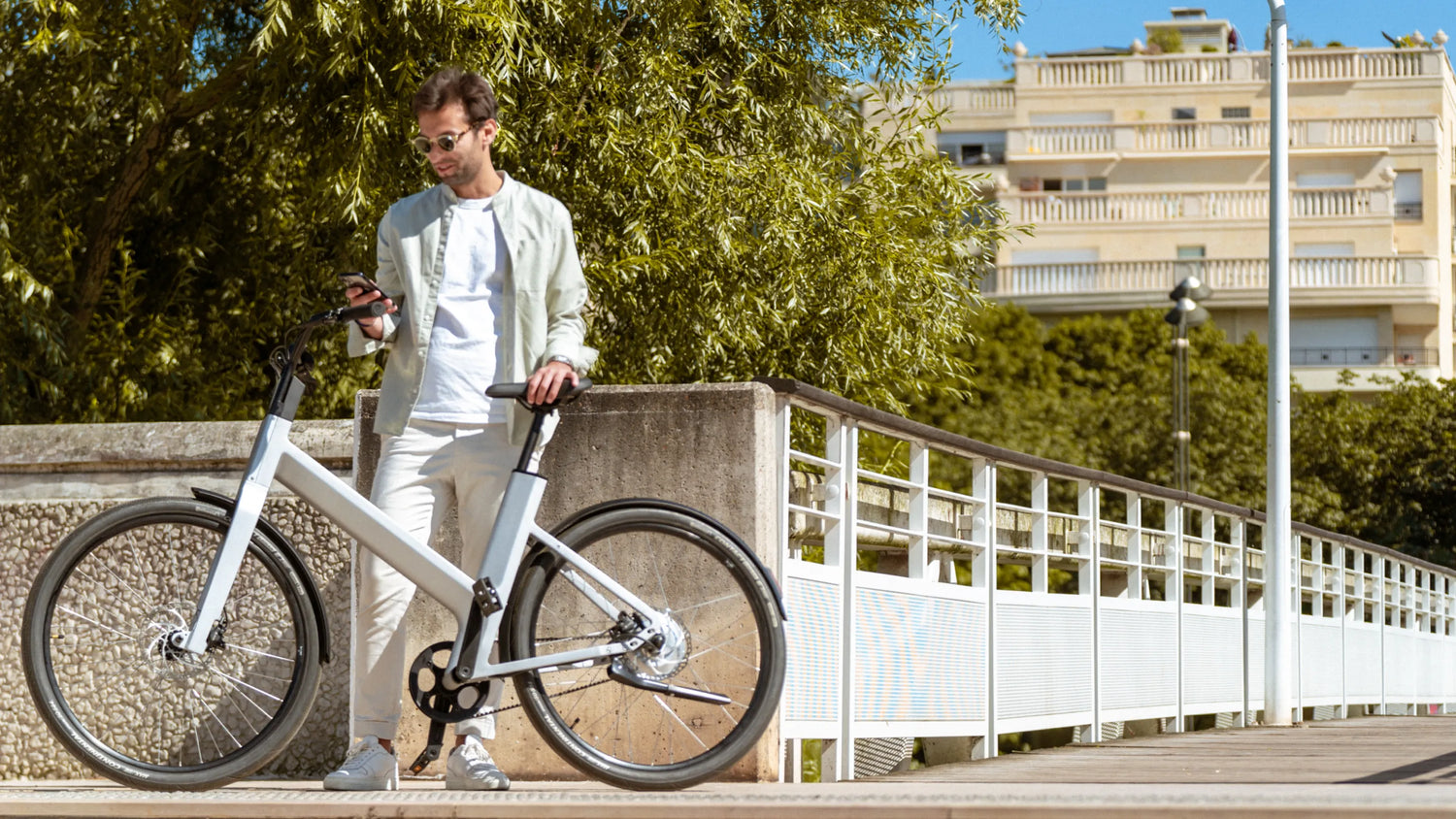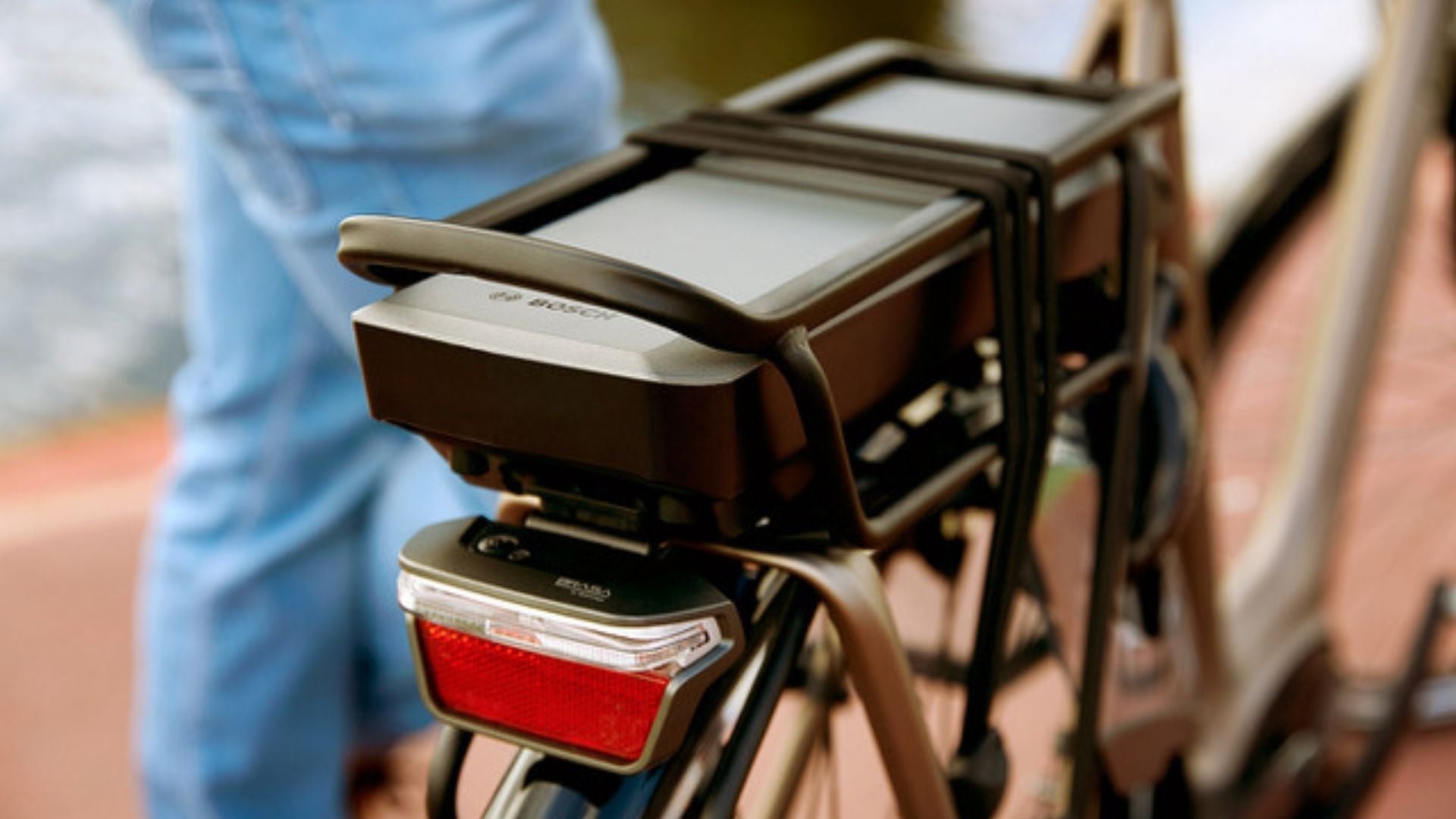Choosing the right bike size is crucial to ensuring a comfortable and efficient cycling experience. Whether you're a beginner or an experienced cyclist, frame size directly influences your comfort, performance, and even safety while riding. This handy guide aims to simplify the selection process by taking into account various factors, such as rider height and bike type, to help you find the perfect bike for your needs and body type. Fortunately, the Anod Hybrid is a bike that has been specifically designed to make your choice easier . Indeed, the Anod handlebar is adjustable to fit any body type, making it accessible to everyone.
Why is bike size crucial?
Bike size is a crucial factor to consider when purchasing a bike. The wrong size can significantly impact a rider's comfort, performance, and safety. Studies and cycling experts have demonstrated the importance of choosing the right size e-bike to optimize the riding experience.
First of all, a rider's comfort is greatly influenced by the size of their bike . If the bike is too big or too small, it can lead to an uncomfortable riding position. An incorrect position can cause pain in the back, neck, shoulders, and wrists. Studies have shown that cyclists who ride the right size bike have better posture and are less likely to suffer from chronic pain.
When it comes to performance, an improper size can limit a rider's abilities . A bike that is too large can make handling difficult, while a bike that is too small can lead to a loss of pedaling efficiency. Cycling experts recommend choosing a bike size that allows for an optimal position to transfer power from the legs to the pedals. This helps improve pedaling efficiency and achieve better performance when cycling.
Are urban bike commutes a regular part of your daily life? The right size bike has a positive impact on cyclists' urban behavior. A well-fitting bike makes it easier to stop and start at traffic lights, which is essential in urban areas where interactions with other road users are frequent. This contributes to better traffic flow and a more harmonious coexistence with vehicles and pedestrians.
Did you know?
If getting off your bike is difficult despite having the saddle adjusted to the correct height, consider moving forward in front of the saddle when you're stationary. This reduces the risk of injury, especially if your bike frame is particularly high. When buying a bike, choosing the right frame size will help ensure your safety during your rides.
Understanding Bike Sizes
It's important to understand the many measurement systems used to better understand the different bike sizes available. For example, road bikes are usually measured in centimeters, while mountain bikes are often measured in inches. These measurements refer to the bike's frame size , which is crucial for ensuring a comfortable and secure fit.
For road bikes, frame size is measured from the center of the bottom bracket to the top of the seat tube. This measurement determines the frame height and is essential for ensuring an optimal riding position. For mountain bikes, frame size is usually measured in inches and refers to the length of the seat tube, which influences the height of the bike and the distance between the rider and the handlebars.
More specifically for city bikes, the size may be indicated in the same way as for road bikes or mountain bikes, depending on the manufacturer. However, the emphasis is on ease of use and comfort in an urban environment, which usually means a frame designed to allow easy mounting and dismounting, suitable for varied daily use.
Wheel size is also an important consideration when choosing a bike. Road bikes typically have 700c wheels, while mountain bikes come in different sizes, such as 26-inch, 27.5-inch, or 29-inch. Wheel size affects handling, speed, and ride comfort, so it's essential to choose the right size for your needs and riding style.
To learn all about the anatomy of electric bikes, you can read our guide on the subject.
Bike size by type
The size of a bike can vary depending on the type of bike you choose.
- For city bikes , sizing should promote optimal comfort and ease of maneuvering in urban environments, with frames designed for easy mounting and dismounting, as well as an upright posture that reduces strain on the back and shoulders while improving visibility in traffic.
- For a mountain bike , the recommended size may be slightly smaller to allow for better handling on rough terrain.
- For a road bike , the size can be larger to facilitate an aerodynamic position and better pedaling efficiency.
- For hybrid bikes , the size can be intermediate to offer a good compromise between comfort and performance.
It's important to consider not only the bike frame size, but also the seat height and handlebar length to ensure an optimal fit. The wrong bike size can lead to pain and injury, as well as a less enjoyable riding experience. Therefore, it's recommended to consult a professional at a bike shop for personalized advice on the right bike size for your body shape and riding style.

How to choose the right bike size?
To choose the right bike size, it is essential to consider the individual's height . A simple method is to measure the person's inseam and multiply it by 0.65. This will give you an estimate of the appropriate bike frame size, although this size may need to be adjusted slightly based on individual preferences and the specific geometry of the bike. It is also important to remember that frame size can vary depending on the type of bike, whether it is a road bike, mountain bike, or hybrid bike.
Here is a size-height correspondence table to help you choose the right bike size:
|
Inseam Height (cm) |
Frame size (cm) |
Frame size (inches) |
|
68 cm |
48 cm |
14 p |
|
73 cm |
48 cm |
14 p |
|
74 cm |
48 cm |
14 p |
|
75 cm |
50 cm |
14 p – 16 p |
This chart shows recommended frame sizes based on an individual's inseam height.
Did you know?
In cycling, inseam height refers to the distance between the ground and your crotch. It's the highest point you can reach on the inside of your legs while remaining barefoot. To correctly measure your inseam, follow these steps:
- Stand up straight against a wall, barefoot, with your feet a few inches apart.
- Use a book or similar object , placing it between your legs, as if you were sitting on the saddle. Make sure the object is snug against your crotch, simulating the pressure of the saddle.
- Measure the distance from the top of the object to the floor , using a tape measure. This measurement is your inseam length.
What size bike for 1.75m?
For a person who is 5'9", the recommended bike size will depend on the type of bike and the intended use. Generally, for someone this height, a medium to large bike would be ideal . For example:
- For a road bike, a frame size of 53 cm would be appropriate.
- The measurement will be the same for a hybrid bike.
- For a mountain bike, an 18-inch frame size might be suitable.
What size bike for 1.70m?
For a person measuring 1.70m, it is recommended to choose a bike with a frame size adapted to their height . In general:
- For a road bike, a frame size of 52 cm would be appropriate.
- The measurement will be the same for a hybrid bike.
- For a mountain bike, a 16-inch frame size might be suitable.
What size bike for a child?
When it comes to choosing the size of a bike for a child, it is important to take into account certain specificities.
First of all, it is essential to consider the bike's scalability, that is, its ability to adapt to the child's growth. It is best to opt for a bike with an adjustable seat and handlebars, so that the height can be adjusted according to the child's size over time.
Safety is also a crucial aspect when choosing the right size bike for a child. It is recommended to choose a bike with wheels that are suitable for the child's size to ensure better stability. In addition, it is important to check that the brakes are easy to use and that the bike is equipped with reflectors or lights for better visibility.
Here is an age-size correspondence table to help you choose the right bike size:
|
Ages |
Wheel Sizes (inches) |
|
2 – 5 years |
12 p |
|
3 – 6 years |
14 p |
|
4 – 7 years |
16 p |
|
5 – 9 years |
18 p |
|
6 – 10 years |
20 p |
|
9 – 13 years old |
24 p |
|
12 – 14 years and over |
26 p |
This table shows the recommended bicycle wheel sizes based on the child's age.
Answers to frequently asked questions
What size bike for my height?
When determining the ideal bike size for your height, it's important to consider several factors. A common method is to multiply your height by 0.65 to get the recommended frame size. For example, if you're 170 cm tall, you could multiply this by 0.65 to get an approximate frame size of 55 cm. However, it's always best to consult a professional at a bike shop for personalized advice.
Another way to determine the right bike size is to use an online calculator tool . There are many calculators available on the internet that take into account factors such as your height, inseam, and preferred bike type to recommend a specific frame size. These tools can be helpful for a quick estimate, but again, it is recommended to consult an expert for more specific advice.
How do I know if the bike is the right size?
There are several criteria for assessing whether a bike is the right size and fits its user well.
- It is important to check the position of the feet when riding . The feet should be able to touch the ground easily when sitting on the saddle, without having to stretch or lean excessively. This ensures stability and optimal control while riding.
- Knee angle is another important indicator. When pedaling, your knees should be slightly bent with each pedal stroke. If your knees are too bent or too straight, this can cause pain and long-term injury. Therefore, it is essential to choose a bike whose size allows for a comfortable and natural knee angle while riding.
- Overall comfort while riding is also a key consideration. Make sure the handlebar and seat position allows you to feel comfortable and in control. If you feel too stretched out or too bent over, it can lead to back, neck, or wrist pain. Choose a bike that allows you to maintain a relaxed and natural posture while riding.
What size bike for what age?
It is crucial to choose the right size bike for your child based on their age.
- For children aged 2 to 4 , a bike with 12-inch wheels is recommended. This will allow them to feel comfortable and safe when learning to ride a bike. It is important to leave some space so they can grow and not feel cramped on their bike.
- For children aged 4 to 6 , a bike with 16-inch wheels is generally more suitable. This will allow them to continue learning and improving while feeling comfortable on their bike. Make sure you adjust the saddle and handlebars to the correct height so they can pedal comfortably and safely.
- For children aged 6 to 9 , a bike with 20-inch wheels is ideal. This will allow them to continue developing their cycling skills while feeling comfortable and in control. Remember to regularly check the size of your child's bike to ensure it is still suitable for their growth. Allowing room for growth is essential for them to fully enjoy their cycling experience.
Anod doesn't currently offer a children's bike, but who knows, maybe the idea will catch on. The love of cycling has no age limit after all, so stay tuned!
What size bike should I get if I'm 1.70m tall?
When you're 5'7", it's important to choose a bike with a frame size that's appropriate for your height. For someone this tall, a medium to large bike frame would generally be recommended. You'll likely feel most comfortable on a bike with a frame size of 52cm (road/hybrid bike), or 16" (mountain bike). However, it's also essential to consider other factors such as your leg length, arm length, and your preferred riding position.
For someone who's 5'7", it's a good idea to try out different bike models to find the one that suits you best. Make sure the frame height allows you to sit comfortably on the saddle and reach the handlebars without overreaching. You can also adjust the saddle height and handlebar position for a more personalized fit.
Conclusion
Choosing the right bike size is an essential step in ensuring a pleasant and efficient cycling experience. By considering factors such as your height, body type, and the type of bike you're considering, you can avoid the pain and discomfort associated with an ill-fitting frame while maximizing your riding enjoyment. This is why the Anod bike is highly recommended. Its adaptability to multiple body shapes makes it the ideal choice for everyone.
We hope this guide has been helpful in understanding the importance of choosing the right bike size and will help you make an informed decision on your next purchase. Feel free to share your experiences or ask additional questions in the comments below. We're here to help you find the perfect bike for you, so you can enjoy every ride.






